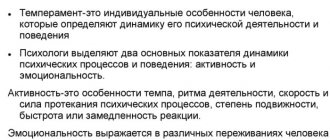This person loves to dress shockingly: if he wears a hat, then with ostrich feathers; if shoes, then on a 25-centimeter platform; if it’s a jacket, then it must have rhinestones. He speaks pretentiously and floridly. He gestures actively and rolls his eyes theatrically. His whole appearance carries one single message: “I am special, look at me!” This is a hysterical type of personality who cannot live a day without the attention and admiration of others.
general characteristics
Hysteroid is a type of personality accentuation, characterized by an irrepressible and uncontrollable desire to constantly be in the center of attention. Their main goal is universal admiration and worship. In order to receive praise, they can take unprecedented measures and shocking actions that shock the public. If no one shows interest, they become very upset and may become depressed and even get sick. In socionics, this is a pronounced demonstrative psychotype, working exclusively for the public.
Physiology:
- weak nervous system;
- poor tolerance to any stress (physical, emotional, intellectual);
- poor health, likes to get sick (to attract attention).
Leading features:
- demonstrativeness, deliberate mannerism;
- the desire to constantly and at any cost be in the center of attention;
- thirst for admiration, veneration, adoration, worship.
The entire description of the character of a hysterical personality type is contained in one phrase: “Idolize me!” Negative features:
- tendency to intrigue;
- idle talk, ability to perform verbal balancing act;
- hypocrisy;
- cockiness, feigned belligerence, readiness to rush into a fight at any moment, starts up half a turn;
- recklessness, carelessness, recklessness - lack of plans for the future;
- reckless risk;
- boasting mixed with lies about non-existent successes;
- selfishness;
- heightened self-esteem;
- love of social life and empty entertainment;
- touchiness.
The “weak link” of a hysterical personality type is a blow to self-esteem and the exposure of fantasies about oneself.
Positive features:
- perseverance and perseverance in achieving goals;
- initiative, enterprise, quick generation of good work ideas;
- communication skills;
- resourcefulness, intelligence;
- activity, energy;
- excellent organizational skills, leadership qualities;
- autonomy, independence;
- pronounced individualism, originality, originality;
- an increased level of empathy, the ability to deeply understand another person, however, this knowledge is used purely for the benefit of the hysteroid, to satisfy some of his whims, to achieve his goals.
The hysterical personality type burns out very quickly. After each burst of energy and outburst, he feels completely exhausted and exhausted, takes a break and goes to rest in silence and solitude. Distinctive appearance features:
- well-groomed, impeccable appearance;
- love for fancy styles and acidic tones in clothes;
- unusual hairstyles;
- bright makeup;
- pretentiousness;
- in old age - the desire to “look younger”;
- demonstrating with all their appearance that they are not like everyone else;
- light, graceful gait “from the hip”;
- lively, emotional facial expressions;
- active gestures;
- smooth movements;
- good, refined figure.
Before Freud, hysterics in psychology were considered as personality types characteristic exclusively of the female sex. However, after the father of psychoanalysis personally admitted that he was prone to the traits inherent in this accentuation, this postulate was revised.
This type is described in many monographs and manuals and is included in a wide variety of taxonomies of psychopathy. Its main feature is boundless egocentrism, an insatiable thirst for constant attention to one’s own person, admiration, surprise, veneration, and sympathy. At worst, even indignation or hatred of others towards oneself is preferred, but not indifference and indifference - just not the prospect of remaining unnoticed (“thirst for increased evaluation” according to K-Schneider, 1923). All other qualities of the hysteroid are fueled by this trait. Suggestibility, which is often brought to the fore, is distinguished by selectivity: nothing remains of it if the situation of suggestion or the suggestion itself does not “give grist to the mill of egocentrism.” Deceit and fantasy are entirely aimed at embellishing one’s personality. Apparent emotionality actually turns into a lack of deep, sincere feelings with great expression of emotions, theatricality, and a tendency to show off and pose.
Hysterical traits often appear from an early age. Such children cannot stand it when others praise them in front of them, when others are given more attention. They quickly get bored with toys. The desire to attract attention, to listen to admiration and praise becomes an urgent need. They willingly read poetry in front of the audience, dance, sing, and many of them really show good artistic abilities. Academic success in the early grades is largely determined by whether they are held up as an example to others.
With the onset of puberty, a sharpening of hysteroid features is usually observed. As is known, in recent decades the picture of hysteria in adults has changed significantly. Hysterical fits, paralysis, etc. have almost disappeared. They have been replaced by less severe neurasthenic-like symptoms [Karvasarsky B.D., Tupitsyn Yu.Ya., 1974; Karvasarsky B.D., 1980]. This also applies entirely to adolescence. However, during this period, hysterical character traits manifest themselves primarily in behavioral characteristics, in adolescent behavioral reactions. In addition, the acceleration of physical development has significantly changed the previous idea of the infantile grace, fragility, and childishness of hysterical adolescents. Only with one of the options we described (“labile hysteroids” - see page 113) is it often possible to encounter a graceful appearance. In other cases, there may not be a trace left of it.
Among the behavioral manifestations of hysteria in adolescents, which serve as the reason for contacting a psychiatrist, suicidal demonstrations should be put in first place - they were the reason for referral to a teenage psychiatric clinic in 80% of cases of hysteroidal psychopathy and character accentuations. According to our observations, the first suicidal demonstrations in accelerated adolescents often occur at the age of 15-16 years. In this case, methods of “suicide” are chosen only those that are safe (cutting the veins on the forearm, medicines from a home medicine cabinet) or designed to ensure that a serious attempt will be warned by others (preparing for hanging, depicting an attempt to jump out of a window or throw yourself under a vehicle in front of those present and etc.). Abundant suicidal “alarming” often precedes or accompanies a demonstration: farewell notes are written, “secret” confessions are made to friends, “last words” are recorded on a tape recorder, etc.
The reason that pushed the hysterical teenager to “suicide” is most often cited by him as “unsuccessful love.” However, it is usually possible to find out that this is just a romantic veil or simply an invention aimed at “ennobling” one’s personality and creating an aura of exclusivity around oneself. The real reason is usually wounded pride, loss of valuable attention for a given teenager, fear of falling in the eyes of others, especially peers, and losing the halo of a “chosen one.” Of course, rejected love, a breakup, and especially the appearance of a rival or rival deals a sensitive blow to the egocentrism of a hysterical teenager, if, moreover, all events unfold in front of the eyes of friends and girlfriends (see Mikhail B., p. 18).
Another reason for a suicidal demonstration may be the need to get out of a dangerous situation, to avoid serious punishment, evoking sympathy, pity, and compassion.
The suicidal demonstration itself, with the worries of others, the bustle, the ambulance, the curiosity of random witnesses, gives considerable satisfaction to hysterical egocentrism.
In search of the real reasons for a suicidal demonstration, it is important to note where it is committed, to whom it is addressed, whom it should pity, whose lost attention it should regain, who it should be forced to make concessions or denigrate in the eyes of others. If, for example, the reason is declared to be a discord with her beloved, and the demonstration is carried out in such a way that she cannot not only see, but also cannot find out about it, but her mother becomes its first witness (Nikita B., p. 17), there is no doubt that that it is in the relationship with the mother that the conflict lies. If the reason given is the rejected love of a girl who lives in another city and no one knows her here, and a demonstration (an attempt to throw herself from the embankment into a canal in front of passers-by) takes place in front of the doors of her educational institution, a very prestigious one, then the inevitable threat soon becomes clear exception for poor academic performance. Parents, however, often play the role of a “scapegoat” among hysterical teenagers for the “disappointments” that befall them among their peers. In cases of hysterical psychopathy, suicidal demonstrations can be carried out repeatedly, especially if the previous ones were successful, and can turn into a kind of behavioral cliche, which is resorted to in various kinds of conflicts [Alexandrov A. A., 1973]. Suicidal demonstrations are accompanied by bravado of “playing with death” with a claim to gain a reputation as an exceptional person.
In addition to suicidal demonstrations, with the hysteroid type of psychopathy and accentuations one also encounters acute affective suicidal reactions, which are more frequent in labile hysteroids. Such affective reactions are also most often caused by blows to self-esteem, humiliation in the eyes of others, loss of hopes for a special role, or the prospect of rising in someone else's eyes. Affective suicide attempts are usually filled with elements of demonstrativeness and are aimed at attracting everyone's attention. However, they are not just a performance - against the backdrop of strong affect, at some point a true suicidal goal or a desire to entrust one’s fate to chance (“come what may”) may flash through. Against the background of affect, even in the absence of a true intention to die, the line of what is safe in actions can easily be crossed, and an action that is demonstrative in plan can end in complete suicide - such power of affects is especially inherent in the mixed hysterical-epileptoid type.
The “flight into illness” characteristic of hysterical natures in difficult situations, the depiction of mysterious unknown diseases sometimes takes on a new form among some teenage groups, for example those imitating Western “hippies,” expressed by the desire to end up in a psychiatric hospital and thereby gain a reputation for unusualness in such an environment. To achieve this goal, not only suicidal threats are used, but also playing the role of a drug addict and, finally, complaints drawn from books on psychiatry, and various kinds of depersonalization-derealization symptoms, ideas of influence and cyclical mood swings are especially popular.
Alcoholization can also be purely demonstrative. Full-blown alcoholism in hysterical adolescents is quite rare, and usually in these situations there is a combination of hysterical behavior with traits of another type. As a rule, hysterical teenagers drink a little, prefer mild degrees of intoxication, but are not averse to boasting about the huge amount they drink, their ability to drink without getting drunk, or an exquisite selection of alcoholic beverages (“I only drink cognac and champagne,” said a 14-year-old hysterical teenager) . However, according to our employee Yu. A. Strogonov, in asocial companies, where the ability to drink a lot causes “respect,” hysterical teenagers, wanting to give the impression that they can “outdrink everyone,” become victims of their pretensions and can actually become addicted to alcohol. However, they are not inclined to portray an alcoholic, since this role does not promise them either an aura of unusualness or greedily curious glances.
The delinquency of hysterical teenagers is usually not serious. We are talking about absenteeism, reluctance to study and work, since the “dull life” does not satisfy them, and they lack neither the ability nor perseverance to take a prominent place in study or work, which would please their pride. Clashes also occur over defiant behavior in public places, harassment of foreign tourists, and noisy scandals. In more serious cases, one has to deal with fraud, forgery of checks or documents, deception and theft of persons in whom confidence has been gained. Hysteroids avoid everything associated with gross violence, robbery, burglary, risk, and, apparently, are relatively rare among criminal teenagers [Ozeretsky N. I., 1932; Mikhailova L. O., 1976]
Running away from home can begin from the first grades of school and even in preschool age. They are usually caused by punishments that have taken place or expected, or due to one of the children's behavioral reactions - the reaction of opposition. This reaction in children and adolescents is more often associated with the loss of former attention from loved ones. Having run away from home, they try to stay where they will be looked for, or to attract the attention of the police so that they are brought home or their parents are called, or, finally, in some indirect way they signal their parents about their whereabouts. With age, shoots can become longer and acquire a romantic overtones. Their reasons are often the same as those that push them to a suicidal demonstration - loss of attention, collapse of hopes for an exalted position, the need to extricate themselves from history, which inevitably threatens to be ridiculed and cast down from an honorable pedestal. For example, having assured his acquaintances that his parents occupied a high position and talked about the “luxurious” lifestyle of their family, a 16-year-old boy ran away to distant lands when the demands of his friends to invite him to his home became too insistent.
Hysterical teenagers retain the features of childhood reactions of opposition, imitation, etc. Most often we see the reaction of the opposition to the loss or decrease in the usual attention from relatives, to the loss of the role of the family idol. Manifestations of the reaction of opposition may be the same as in childhood - “flight into illness” or attempts to get rid of the one to whom attention has switched (for example, forcing a mother to break up with her stepfather), but more often this childish reaction of opposition is manifested by behavioral disorders - sudden drinking, theft, absenteeism, and antisocial company are intended to signal to loved ones: “Give me back my former attention and care, otherwise I will disappear!”
The imitation reaction can determine a lot in the behavior of a teenager of the hysterical type. Hysteroids are generally unoriginal, and their entire life path is an imitation of someone, although this is done as unnoticed as possible and is always presented as “their own.” The model chosen to be imitated by a hysterical teenager should not, first of all, overshadow the imitating person. Therefore, for imitation, an abstract image or (more often) a person who is popular among teenagers, but does not have direct contact with this teenage group (“fashion idol”) is chosen. Sometimes imitation is based on a collective image: in efforts to achieve originality, the stunning statements of some, the unusual clothes of others, the provocative manner of behavior of others, etc. are reproduced.
The reaction of overcompensation is less characteristic of hysteroids, since it is associated with perseverance and tenacity in achieving the goal, which the hysterical nature lacks. But the compensation reaction can be quite pronounced. One might think that it is precisely this reaction that plays a significant role in the “cosmetic lies” characteristic of hysterics, in the fantasies that they force others to believe and, if they do not believe themselves, then at least enjoy them.
The fantasies of hysterical teenagers differ sharply from the fantasies of schizoids. Hysterical fantasies are always intended for certain listeners and viewers, so they are changeable, taking into account their interests, tastes, and situation. Hysterical teenagers easily get used to a fictitious role and behave accordingly. Gennady U. (p. 13) was taken to a teenage psychiatric clinic after he came to the state security authorities with a statement that he had been recruited by foreign intelligence, was instructing him to carry out an explosion at a factory, pointed to certain individuals as agents of this intelligence, etc. ... which, of course, was pure fiction.
Since the time of E. Kraepelin (1915), hysterics prone to such myth-making have often been classified as a special group of psychopathic pseudologists or mythomaniacs. From our point of view, for adolescence it is hardly justified to single out this special group, since fantasies and lies that decorate one’s own personality are characteristic of almost all hysterical teenagers. And even when inventions constitute the main thing in behavior, seemingly overshadowing all other hysterical traits, all these tales are always fueled by the basis of the hysterical character - insatiable egocentrism.
Teenage behavioral reactions are also colored by this main hysterical trait. The emancipation reaction can have violent external manifestations - running away from home, conflicts with relatives and elders, loud demands for freedom and independence, etc. It can clearly manifest itself when examined with the help of PDO. It may also be responsible for demonstrative nonconformism—a ostentatiously displayed denial of generally accepted norms of behavior, widespread ideals, views, and tastes. However, in essence, the real need for freedom and independence is not at all characteristic of teenagers of this type - they do not at all want to get rid of the attention and worries of loved ones. As a result, emancipatory aspirations often slide onto the rails of the childish reaction of the opposition.
The reaction of grouping with peers is always associated with claims to leadership or, in any case, to an exceptional position in the group. Possessing neither sufficient sternness nor a fearless readiness at any moment to forcefully assert his command role and subjugate others, the hysterical teenager strives for leadership in ways accessible to him. Possessing a good intuitive sense of the mood of the group, the still brewing and sometimes still unconscious desires and aspirations in it, hysterics can be their first spokesmen, act as instigators and incendiaries. In an impulse, in ecstasy, inspired by the glances turned to them, they can lead others, even show reckless courage. But they always turn out to be leaders for an hour - they give in to unexpected difficulties, easily betray their friends, are deprived of admiring glances, and immediately lose all their enthusiasm. The main thing is that friends will soon recognize their inner emptiness behind the external effects. This happens especially quickly when a leadership position is achieved in a different and more accessible way for a hysterical teenager - by throwing dust in the eyes with stories about his past successes and adventures. All this leads to the fact that hysterical teenagers are not inclined to stay too long in the same teenage group and willingly rush to another to start all over again. If you hear from a hysterical teenager that he is disappointed in his friends, there is no doubt that they are the ones who have already figured him out.
In conditions of closed teenage groups, for example, in closed teenage institutions with a regulated regime, where an arbitrary change of company is difficult, in order to occupy an exceptional position, a different path is sometimes chosen. Hysterical teenagers willingly accept leadership functions from adults - positions of elders, organizers of all kinds of events - in order to take the position of mediator between elders and other teenagers and thereby strengthen their special position.
Hobbies are almost entirely concentrated in the area of the egocentric type of hobby. Only something that gives you the opportunity to show off in front of others can captivate you. If you have the ability, then amateur artistic activity opens up the greatest opportunities here. Preference is always given to those types of art that are currently the most fashionable among teenagers in their circle (in our period - pop ensembles) or can amaze with their unusualness (for example, mime theater). It was impossible not to notice among teenagers in the 60s and 70s the low popularity of drama clubs and the declining popularity of dance ensembles. Sometimes the chosen hobbies, at first glance, do not belong to egocentric hobbies. However, in fact, it turns out that enthusiastic study of a foreign language, which usually comes down to mastering the most popular dialogues, is undertaken in order to show off in front of friends by talking with foreign tourists, and passion for philosophy is limited to the most superficial acquaintance with fashionable philosophical movements and is again intended to make an impression on the relevant environment with your knowledge. Imitating yogis and hippies provides particularly fertile ground in this regard. Even collected collections can serve the same purpose - to show off them (and yourself!) in front of your friends (Alexander F., p. 16). Sports and other manual-bodily hobbies are chosen much less frequently, as they require great perseverance to achieve a prestigious position. In contrast, leadership hobbies (the role of various types of organizers and managers) are more preferable, as they allow you to always be in sight. However, they soon begin to become burdensome with the formal responsibilities associated with them.
The sexual desire of hysteroids is neither strong nor intense. There is a lot of theatrical play in their sexual behavior. Male teenagers prefer to hide their sexual experiences and avoid conversations on this topic, because they feel that there is nothing to amaze them with here, they are afraid of being “not up to par.” Girls, on the contrary, tend to advertise their real connections and invent non-existent ones, are capable of slander and self-incrimination, and can play the role of sluts, enjoying the stunning impression on the interlocutor.
It should be emphasized that the weak link of the hysteroid type, a blow to which can reveal hysterical traits with hidden accentuation or cause a bright hysterical reaction with obvious accentuation, most often are injured pride, loss of attention from those around them or especially significant people, collapse of hopes for a prestigious position, debunked exclusivity .
The self-esteem of hysterical teenagers is far from objective. Those character traits that can make an impression at the moment are exposed.
In hysterical psychopathy, the aggravation of character traits occurs both along the path of intensification and frequency of acute affective reactions of a demonstrative type with repeated performances depicting the desire to commit suicide, and along the path of other demonstrative behavioral disorders.
In severe hysterical psychopathies, under the influence of mental trauma, reactive hysterical psychoses can develop - hysterical twilight states, pseudodementia, etc. However, in our time, hysterical psychoses in adolescents are rarely encountered and mainly in the situation of a forensic psychiatric examination.
Hysterical psychopathy can be either constitutional or a consequence of psychopathic development, more often on the basis of hysteroid, as well as labile or hyperthymic accentuations of character when raised in conditions of indulgent hyperprotection.
In the teenage population, hysterical accentuation is found in 2-3% of male adolescents and somewhat more often in female adolescents [Ivanov N. Ya., 1976].
Three variants of the hysteroid type are most common in adolescence. The “pure” asteroid type does not require any special description; examples of various degrees of psychopathy and character accentuation of this type are given in Chapter. I. Labile hysteroid is presented in the section on the labile type (p. 113). The hysteroid-unstable type is quite common, although it has not yet been sufficiently studied [Alexandrov A. A., 1978].
Hysteroidal-unstable type. This type is common among adolescent males. Most of them lack the infantility and gracefulness of physique characteristic of classical descriptions of hysteroids. On the contrary, the acceleration of physical development is usually quite pronounced. Outwardly, when they first meet, such teenagers may seem unstable. Antisocial company of peers, drinking, idleness and craving for a “fun life”, neglect of one’s responsibilities, avoidance of study and work - all this really occurs. However, behind all this is not thoughtlessness, not an almost instinctive craving for constant entertainment and pleasure, but the same egocentrism. All manifestations of antisocial behavior: alcoholism, delinquency, etc. - serve for bravado in front of elders and peers, in order to at least in this way earn a reputation for exclusivity. In asocial companies themselves, a claim to leadership and unusualness is revealed. Idleness and dependency are associated with high, virtually impossible demands regarding a future profession. Falsehood is not only defensive, as with unstable people, but it almost always serves the purpose of embellishing oneself. In delinquent behavior, artistic abilities are skillfully used (the ability to gain trust, skillful deception, etc.).
Alexey D., 17 years old. Father and mother have been divorced for many years, although they live in the same apartment. Doesn't communicate with father. He developed normally, studied satisfactorily until the age of 13, and had no behavioral disorders. In the 6th grade, studying seemed difficult, I abandoned classes, and got involved with an antisocial group of teenagers. He began to engage in “farming” - he bought and resold the things of foreign tourists. He earned a lot of money from this - he began to dress in the latest fashion. He announced to his mother that he had a sailor friend who brought everything from abroad. At the age of 14, I went to Tallinn and Kyiv with two friends - I called my mother from the station so that “not to worry.” He stated that he wanted to see beautiful cities, but was detained by the police there due to speculation.
I barely finished 8th grade. At the insistence of his mother, he entered a vocational school, but there he constantly skipped classes. At the age of 16, he was convicted of participating in a gang fight. He claims that he got into this company by accident and was “slandered.” He was soon released from the colony due to an amnesty. There, according to him, he easily established contact with his comrades, but was oppressed by the harsh regime. After his release, he first returned to vocational school, but soon dropped out of classes. I spent all my days in some company. According to his mother, a nurse, he began to return home in an unusual state, somehow excited. The mother suspected the use of intoxicants. He was sent for examination to a teenage psychiatric clinic.
The clinic behaves pretentiously. Proud that he has a “foreign surname.” During a conversation, he shows off and rolls his eyes flirtatiously. He said that he avoids booze, doesn’t drink vodka at all, and in groups he tries to drink no more than one glass of weak wine. At the age of 13, I sniffed stain remover with my friends, but soon gave it up - “I got tired of it.” According to him, after leaving the colony, he willingly used various pills (Seduxen, Pentalgin, etc.) in his company, wanting to cause a “high.” Upon admission to the clinic, I did not detect any withdrawal symptoms.
Among teenagers, he claims to be a leader and tries to impress with stories about his asocial past. He refuses to study at a vocational school. He said that he would agree to take a “cook course for overseas voyages,” but then pointedly declared that the “stain of the colony” had ruined his life—they wouldn’t take him anywhere to a “decent place.” He considers studying radio engineering at a vocational school unworthy. He says that he is interested in modern pop music, quickly names several fashionable things and ensembles, but his knowledge here is superficial: apparently, he was more busy speculating on tape recordings than the music itself.
Upon examination, there is a pronounced acceleration of physical development. Height 184 cm with body weight 64 kg. Sexual development is complete. On the body there is a tattoo with criminal symbols (signs of a criminal record, being in prison, a symbol of the desire for “freedom”).
Neurological and somatic examination showed no abnormalities.
Survey using PDO. According to the objective assessment scale, despite the established tendency to character dissimulation, a pronounced hysteroid type was diagnosed. Apparently, due to dissimulation, the traits of the unstable type were not diagnosed. Signs indicating the development of psychopathy have not been established. Due to dissimulation, the determination of other indicators may be incorrect (conformity is average; the emancipation reaction is not expressed, no tendency towards delinquency has been identified). There is a negative attitude towards alcoholism. According to the subjective assessment scale, self-esteem reflects dissimulation and attitudinal behavior: features of the conformal and paranoid type appear, only sensitive traits are reliably rejected (i.e., a desire to show oneself as “correct” and a “strong personality” is revealed).
Diagnosis. Mentally healthy. Behavioral disorders against the background of accentuation of the hysteroid-unstable type.
Follow-up in two years. Re-convicted for profiteering.
Diagnosis of the hysteroid type in adolescents should be carried out with caution. Don't be fooled by the apparent ease. Hysterical traits can be a superficial layering on the characterological basis of another type - labile, hyperthymic, epileptoid and even schizoid. These same traits may be included in the picture of organic psychopathy. Demonstratively suicidal behavior in epileptoid adolescents can also lead to the false idea of hysteria. To what has been said, we should also add the need to differentiate between hysteria and pronounced mental infantilism in adolescence, when one can also encounter unbridled fantasy, inventions, childish emotional expressiveness, suggestibility and many other traits similar to hysteria. However, the absence of pronounced egocentrism makes it possible to distinguish such teenagers from hysterics.
Compatibility of different accentuations
What is the compatibility of a hysteroid and:
- ...hysteroid
These two personalities have a lot to talk about: social gossip, new fashion, trends, the latest collections of Armani and Gucci. However, such communication is very superficial and does not oblige you to anything. It’s difficult for them as a couple, because everyone is able to think and care only about themselves. After the veil of love falls in three months, they will begin to wither due to lack of attention and look for it on the side.
- ...epileptoid
There is only one wealthy couple here: a hysterical woman and an epileptoid man. The wife is a spectacular social beauty, of whom her husband is rightfully proud as his own decoration. He will surround her with luxury and care. She will slowly turn into a manipulator and enjoy his attention. She can go to the left, and if she is caught, she will theatrically wring her hands and demonstratively break dishes. Most often, the epileptoid forgives the betrayal, but after that he takes the hysteroid with a tight grip.
- ...paranoid
Paranoid is a personality type with a strong nervous system. Therefore, a hysterical person can fall in love with him, will walk with his mouth open, listen to every word and worship him almost like a deity. However, he is too fickle, and as soon as a new luminary, broadcasting the truth, looms on the horizon, the hysteroid may move over to him. From the point of view of marriage, a couple of woman-p and man-i will be wealthy. The wife will take on the role of manager in the family and will help her husband achieve career heights. If the gender is the opposite, the superficial and narrow-minded beauty will shake from the rigidity and steadfastness of her husband and secretly cheat on him.
- ...schizoid
These two personality types are radically opposed to form a pair both in communication and in marriage. They have no common themes. They are too different even in appearance: one is stylish and fashionable, and the second is unkempt and unkempt. For this they despise each other. If a spark of love suddenly flashes, the flighty and cheating hysteroid will deeply wound the sensitive schizoid and make him suffer greatly. Relationships are possible only in one case - if it is a marriage of convenience.
- ...hyperthyma
The beginning of their relationship is like a real fairy tale. The hyperthymic personality type knows how to look after beautifully, carries the glamorous hysterical in his arms and blows off specks of dust from him. Walks on a boat, a romantic dinner by candlelight, expensive gifts - all this suits both, until... Until the first one gets tired and immerses himself in another project of his life - and this can be not only a new partner, but also a career, a hobby or something... something else. He loses interest in his former toy, who cannot stand it and, offended, leaves, breaking all the mirrors and dishes in the house.
- ...emotive
Such couples often meet in life and at first they are very happy. Emotive is sincerely in love, surrounds the hysterical personality with care and warmth. And that’s all she needs. Melting away from each other, they are blissful and even get married. However, over time, the emotive begins to understand the superficiality and frivolity of the hysteroid. He becomes offended. He either endures this situation and remains unhappy for the rest of his life, or gets divorced.
- …cycloid
Cycloids are deep people who do not understand and do not accept the posturing and theatricality of the hysteroid. Even if such a couple develops, then until the first depression or hysteria, the cyclothymic. Then a scandal and even a fight cannot be avoided.
Who are hysterics and why do they love hysterics?
Karl Leonhard's typology classifies hysteroids as a demonstrative personality type. In simple words, such people “play to the public” and achieve their goals most successfully in this way.
An explosion of emotional excitement, accompanied by screams, tears, emotionally charged speech and theatrical gestures are characteristic features of hysteria. Most ordinary people cannot stand the sight of hysterical scenes, so they are ready to make any concessions to the hysterics. This is why hysterics love hysterics: they serve them as a means of manipulating other people.
Where does such a manic passion for manipulation come from? The reason is a lack of attention from other people, including of a sexual nature.
The main signs by which you can determine the hysterical personality type:
- ego);
- demonstrativeness, ostentatious emotionality;
- need for attention from certain people;
- thoughtlessness of actions.
Hysterical individuals are not able to think through the consequences of their behavior in advance, so they live in the present moment and, in the wake of egocentrism, use any means of manipulation.
Egocentrism is the determining factor in the behavior of a hysteroid, which determines all other reflexes, reactions and emotions. At the same time, the emotionality that manifests itself extremely theatrically in the hysteroid actually reflects the absence of deep, sincere feelings. The inability to sincere emotions and deep feelings determines the uneven course of life of hysteroids. They are controlled by:
- desire to avoid difficulties;
- tendency to shirk work;
- disobedience to rules.
They can quit work without finishing it, leave without warning, or lose contact without any explanation. They do not care about the feelings of other people, so the rules of etiquette are not perceived by hysterics. This leads to frequent changes of place of work, and even profession.
The only profession for which hysterics can be said to be born is acting. In it, representatives of the hysterical personality type will be able to maximally express their “best” skills: simulation, fantasy, myth-making, affectivity and impressive suicide attempts.
Kinds
In psychology, the hysterical personality type is represented by several types. Therefore, there is a special classification of this character accentuation:
- paranoid hysteroid - fixated on his fame, for which he is ready to move mountains, often achieves popularity;
- hyperthymic - all the traits inherent in the hysterical personality type are manifested as clearly as possible; rude and impudent;
- anxious - too fixated on his appearance and universal adoration, worries and trembles over every failure;
- epileptoid - hot-tempered and irritable, often uses quarrels and even fights to attract the attention of others;
- emotive - experiencing any emotion too much, often ends up with a mental personality disorder;
- schizoid - stubborn, shocking, bright, unusual.
In psychology, there is also a typology of types of thinking by psychotherapist A. Kurpatov, according to which a person of this character accentuation is a hysterical reflector. He perceives the world around him reflexively, through how others treat him.
Mysterious illness
People suffering from hysterical disorder tend to invent and attribute to themselves the presence of unexplained diseases. They colorfully describe symptoms, go into detail, and show dramatic reenactments. Their condition is often accompanied by autonomic disorders that reach extreme levels of manifestation: fainting, attacks of suffocation, nausea, loss of voice, sensitivity, immobility of the limbs.
In search of sympathy and attention, they often visit hospitals, pretending to be sick and helpless. If little attention is paid to them, the attacks intensify. Seeing that they are being watched, patients with hysterical personality disorder perfectly play the role of the sick person. But when they are distracted and forgotten, their condition suddenly improves.
The patient consulted a doctor with complaints of constant weakness and fatigue. I was worried about insomnia, frequent dizziness, and trembling of the limbs. “There are times when my legs give out.” She claimed that she suffered complete paralysis of her arms and legs twice. However, in both cases everything was somehow restored mysteriously. She complained about being in a bad mood.
On examination: she is too cutesy, tries to imitate a staggering gait, loses consciousness. Expresses apathy, worry about the future, talks about his imminent death. Complains of memory loss. But when surrounded exclusively by patients, she transforms, becomes cheerful, sociable, and the lost memory suddenly returns. At a meeting with her husband she becomes a flirtatious, attractive young woman.
Reasons for formation
Depending on the age stage, the factors influencing the formation of the hysteroid personality type vary greatly.
- In early childhood
In childhood, upbringing plays an important role. When a child goes through a 3-year-old crisis, he often has tantrums. If parents learn to respond to them correctly, the tantrums will subside after a while and will not recur. If the situation is aggravated, this will develop into a stable accentuation of character and will contribute to the formation of a hysterical personality type.
- At school age
If at school teachers or classmates begin to highlight any of the child’s talents, even if it is in its infancy, a hysterical personality type may well develop. The habit of worship will last a lifetime.
- During adolescence
Here everything can go exactly the opposite. If parents and teachers constantly belittle a teenager's personal dignity and force him to hide his talents and sexuality, he will demonstrate freedom of expression out of spite. Over time, this sometimes goes away, but not for everyone. Someone is forever stuck in this challenge posed to society.
- In adults
Even as an adult, a person can become hysterical. This can be influenced by external factors: for example, unexpected success and sudden drop in popularity. Sometimes the impetus is internal complexes and reserves: severe stress forces you to radically reconsider your views and values, to turn from a gray mouse into a bright peacock. Less commonly, the provocateur is physiology: traumatic brain injury, mental personality disorder, disturbances in the functioning of the nervous system, etc.
Similarity of the hysteroid personality type with others (differential diagnosis)
Hysterical personality versus psychopathic personality
Psychological researchers have found that sociopathy is more common in men, and hysteria in women. Hysterical people are intensely focused on interacting with other people, are conflicted and fearful. The psychologist’s task will be to figure out what fears they have.
And psychopathic people equate fear with weakness and despise psychologists who in any way show their anxiety during a session. Hysterical and associative people behave in the same dramatic way, but defensive hysteria is absent in sociopaths. The psychologist's demonstration of his professional power will have a positive effect on psychopathic clients, but will intimidate or infantilize hysterical patients.
Histrionic personality versus narcissistic personality
Hysterical personalities use narcissistic psychological defenses. Hysterics and narcissists have a significant defect in self-esteem, as well as deep shame, and require compensatory attention and approval from other people, idealize and devalue. For hysterics, self-esteem problems are related to gender identity. People with the Histrionic Organization are generally friendly and caring. But if their sense of fear is affected, they may regress. Hysterics often idealize and devalue a gender-specific image. For example, such a woman client may say: “This wonderful man cannot offend me!” Their behavior can be aggressive.
In contrast to tantrums, narcissistic clients divide all people into the best and the worst. Their behavior is not characterized by affects. The choice of partners among hysterics is focused on “bad” objects that they idealize. For example, a hysterical woman may find, in her opinion, a weak man and try to “pump him up” according to this parameter. And narcissistic individuals choose adequate objects, which they then devalue. For example, such a person may tell his partner, after several years of marriage, that he wasted his time on him.
If you want to learn more about narcissistic personalities, read the continuation of the series of articles here.
We bring to your attention another article about the hysterical personality type: we will consider in more detail the reasons for the formation of such a character and its manifestation.
Peculiarities
Gender
- Men
A male hysteroid often plays the role of gigolo. His appearance is somewhat effeminate, as it contains bright colors, rhinestones, ribbons, and feathers. His wife has a very difficult time with him, since he wants to please all women at once, and he doesn’t give his only one flowers even on March 8th. They are big dreamers, they love to show off and pose even at home. They constantly need an audience. They have thousands of followers on social networks. Therefore, they often either never get married, or their passport eventually runs out of space for marriage stamps.
- Women
The hysteroid woman is a skilled, born coquette. Her main goal in life is a successful, profitable marriage. In marriage, she is a great manipulator who keeps her husband under his thumb. She’s not much of a housewife, but before guests arrive she knows how to give the house an external shine in order to show off. She doesn’t always want and have children, because, in her opinion, they prevent her from building a career and enjoying life. If they do exist, she tries to hire them a nanny or give them to their grandparents or husband to raise. Mom doesn’t care about their interests. But on Instagram she will from time to time publish Stories and selfies with her children to proudly show everyone her status as a Mother.
Age
- In early childhood
The hysterical personality type is clearly expressed from early childhood. Such children are not embarrassed by a large number of adult strangers. They happily recite poems to the public, sing songs, demonstrate all their talents, and show off their outfits. Already at 3-4 years old, the main thing for them is the universal admiration and adoration of others. If for some reason they feel a lack of attention, they will do everything to attract it to themselves. In this case, extreme methods may be used: breaking a plate, throwing a tantrum, clapping your hands, etc. In the family, they are idols that everyone worships. If some of his wishes and demands are not fulfilled, they throw hysterics (banging their heads against the walls, rolling on the floor, screaming heart-rendingly).
- At school age
Such children love to go to school to be the center of attention. They love being prefects. They often achieve excellent success in their studies, only to be paid attention to, applauded, and idolized. For the same purpose, they participate in various school extracurricular productions. If they have any creative talent (they have good vocal or artistic abilities), they become local stars.
Relationships with peers do not work out, since hysterics demand unquestioning obedience. They usually have 2-3 people who follow them, carry their backpack, do their homework for them, since they have convinced them of their exclusivity.
- In teenagers
Among the manifestations of hysteria in adolescence, suicidality comes first. Moreover, most often we are talking about frivolous attempts - so-called pseudosuicides. For example, they do not cut veins, but make shallow incisions in the wrist. Or they drink not a handful of pills, but 2-3, but at the same time they defiantly leave the empty blister on the table and pretend to faint.
- In adults
In adults, everything proceeds according to the same scenario described above (see general information).
- In old age
Hysteroids experience a genuine fear of old age, as they are afraid of losing their freshness and beauty. Therefore, they fight it to the last: they dress more youthfully, resort to plastic surgery, and take care of themselves. And they continue to shock the public: they take young people as husbands (wives), become parents in old age, etc.
Protective and adaptive processes in hysteria
Among them, repression, sexualization and regression are the most important. As a rule, people with a hysterical type of character feel danger from the opposite sex. Regression is characterized by the fact that we forget some events that happened to us. And also there is a process of repression. Repressed memories and the affects associated with them have been studied in psychoanalysis.
The psychologist’s task is to reveal the client’s repressed memories. For example, during a psychological session, a client says that he cannot understand why and where he has such reactions to an event. As we work with it, it turns out that the causes of these reactions are events from early childhood repressed into the subconscious, which the person does not remember.
Sigmund Freud considered the conversion of impulses into bodily symptoms. For example, glove paralysis, when a woman knew about the prohibition of masturbation, but the desire for satisfaction did not disappear. At the same time, numbness of the hands occurred.
Psychoanalysts said that the benefit of such people is the care of others for the woman. This is a conflict between Id and Super ego. Sexual energy is blocked instead of being expressed or sublimated. Outbursts of sexual interest in such clients can be considered as a return of the repressed.
Neurotics convert forbidden sexual energy into diffuse nervousness. People who block sexual urges tend to find conflict with others unacceptable. As a rule, hysterics are sexually unsatisfied and restless, they want intimacy and love. Can be sexually provocative, but don't realize it. At the same time, they are often shocked that their behavior is regarded as an open invitation to sex. If it happens, they may feel guilty about it and, more often than not, do not receive sexual satisfaction.
As a rule, clients with a hysterical personality type resort to regression. Feel insecure or at risk of rejection, which stimulates subconscious feelings of guilt and fear. They may become helpless and childish in an attempt to protect themselves from people whose rejection they fear.
Features of communication
The hysterical personality type builds its communication with the outside world as follows:
- needs a large and admiring public;
- communicates only with those who idolize him;
- makes friends either with famous people in order to move closer to fame at their expense, or with those who are nothing in order to look more advantageous against their background;
- doesn't care about anyone;
- manipulates others;
- promises a lot, but delivers little;
- does not know how to make friends, because he cannot be relied on;
- incapable of deep feelings;
- loves gifts;
- For him, social life, spotlights and his own “ego” the size of an elephant always come first.
The advantages of communicating with a person with a hysterical personality type:
- knows how to speak well and captivates with his oratory;
- makes the partner experience 10 emotions per day with him;
- captivates with its artistry;
- always ready for adventure and something new.
Recommended professions:
- actor;
- singer;
- model;
- Show Business;
- politician;
- speaker;
- salesman.
Tips on how to communicate with a hysteroid:
- accept him as he is and not try to change him;
- not to believe in his stories, but also not to interrupt them rudely: listen and forget;
- do not follow his lead, do not allow yourself to be manipulated or drawn into intrigue;
- do not criticize too clearly, carefully pointing out shortcomings;
- do not let them “go into illness”;
- gradually accustom to responsibilities;
- Say nice things every day, but don’t over-praise.
Adjusting (establishing contact) with a hysteroid is easy. All it takes is sincere praise and he's yours.
Features of the living environment of a hysterical person
Just as in appearance, hysterics behave in exactly the same way in their home or workplace. The decor should match the personality: bright colors, originality, sometimes belonging to a certain subculture. The most important item in the setting is photographs in a prominent place of yourself.
Various personal awards: certificates, cups, prizes are not hidden in closets, lying on the shelf or under the bed. The interior of the hysteroid immediately gives a complete picture of the personality and character of the owner of the room or other premises. Their wardrobe always has a wide variety of clothes and shoes. Her collection is constantly updated with new bright things.
Test for hysterical personality type
Please tick the statements that apply to you:
Interpretation of results:
- 13-15 points - a pronounced hysterical personality type;
- 9-11 - close, there are some similar features, borderline accentuation of character;
- 6-8 - everything is normal;
- 0-5 - you are a balanced person with a strong nervous system.
If the number of points goes off scale, it’s time to take charge of yourself.
Advantages and disadvantages
Obsessive-compulsive personality disorder - what is it?
A hysterical psychopath has strong and weak character traits. He can achieve serious success in life, but at the same time have a number of problems.
Personality advantages:
- positive perception of life;
- activity;
- creativity;
- workaholism;
- courage.
At the same time, hysteria can be characterized negatively:
- there is no criticality;
- egocentrism;
- fussiness;
- no diligence;
- importunity.
The main positive quality of such a person is the ability to attract other people.
Correction
Psychologists give recommendations on how to work on yourself:
- Learn to express yourself simply and concisely. Constantly monitor your voice: do not raise it, speak monotonously and calmly.
- Do a good deed and don't tell anyone about it.
- At your next party, sit back from everyone and try to be noticed by as few people as possible.
- Before you promise anything to someone, think: can you keep your word? If not, don’t reassure the person in vain.
- Learn to accept criticism.
- Go volunteer. At least for a while. You definitely need to learn to empathize with others.
- Develop self-control. Learn to manage your emotions.
- Dress more modestly.
- Try to build a long and strong relationship with the person who is truly dear to you.
If independent attempts do not produce results, it is better to turn to specialists. Psychologists and psychotherapists have their own ways of working with this personality type.
Hysterical self:
The main perception of oneself in hysteria is the feeling of being a small, fearful and defective child in a world dominated by strong others. They can act as controlling and manipulative. People with this personality type want acceptance and security. Their attempts to control and surpass others are aimed at finding an island of safety, in the midst of a frightening world, and making them stable, in the midst of a frightening world, by mastering the situation they provoke. For example, with the help of flattery, a woman achieves a man’s favor. After she notices signals from a man that he has responded to her messages, she feels excited and appreciated. However, there is also a fear that sexual intimacy will be demanded from her. There is also a feeling of guilt from forbidden excitement and imposed sexual interest in her. Such a woman behaves this way with men who have authority.
Famous hysteroids
As you already understood from the description of this personality type, many of the public figures are its prominent representatives. Here are just a few of them:
- pop singer Philip Kirkorov;
- stylist and showman Sergei Zverev;
- politician Vladimir Zhirinovsky;
- American singer Lady Gaga;
- actor Nikita Dzhigurda;
- politician and presenter Ksenia Sobchak;
- as well as Tigger from the American “Winnie the Pooh” and Carlson.
Hysteroids are, without a doubt, bright and unusual people. They need to learn to find a middle ground in communicating with others and not go too far with their outrageousness. Only in this case can they hope for sincere universal love that will make them happy.
Hyperthymic (social) type
This is probably the happiest personality type. His hormonal balance is adjusted so that the person is in a good mood most of the time.
He is sociable, enterprising, resourceful and knows how to find an approach to almost any person, the soul of any company. But he doesn’t always bring things to fruition.
We need something new. Always changing jobs, friends, hobbies, cities, vacation spots. Loves everything new that he has not tried before.
It's not all serious. These are very easy-going and positive people. They love to play, they love intrigue and adventure, they love risk. And no restrictions, obligations or serious perception are needed. The main thing is to get emotions during the game. But the game cannot be serious.
How to recognize it?
He talks constantly and his speech rate is fast. Bright and active. Lively facial expressions, a lot of emotions on the face and chaotic body movements. Always smiling and radiating positivity. Wide movements. Takes up as much space as possible.
How to please him?
We need someone who is just as active and passionate. He loves light and cheerful people who do not sit in one place. He wants to travel the world together, experience new emotions and impressions together.
Give him bright emotions. Emotions are what he breathes, what he lives. He doesn't need any depth or any affection. What is important is passion and vivid impressions.
Play with him, intrigue him. I wrote and offered to meet, but canceled half an hour before the meeting. Today it’s closer, tomorrow it’s farther away. All manipulations can be used. And don’t forget that he is the same player and intriguer.
The main principle of communicating with him is that everything is not serious. As soon as it gets serious, his interest will pass.
What is he like in a relationship?
There will never be a dull moment with him. With sparkle in his eyes and enthusiasm, he will charge you with a stream of positive energy. He is always carried somewhere. It is unknown whether he will return home at all today.
Not at all reliable. He can at any moment become enchanted by another person, change his occupation, move to another city...
Does not see his own shortcomings, but can find fault with his partner’s shortcomings. He gets bored with his partner quickly, and he finds a million superficial reasons why.
Open relationship. He does not want to commit himself. Falls in love quickly, burns out quickly. Not inclined to have a long-term relationship with the same woman.
How to live with him?
Don't try to tie him - it's useless. Give him freedom, then he won’t want to go anywhere. By the way, he likes a certain inaccessibility of a woman when he is more interested in the relationship than she is.
Always surprise him, always impress him with something new. Don't sit still on the couch watching TV in the evenings. He needs some new impressions, joint trips, movement, drive. Give him something new all the time, impress him.
Do not demand loyalty and constancy from him. It is pointless. He will always be attracted to new women.
What is absolutely forbidden?
- Prohibit communication with people. Hyperthymus needs communication like air.
- Forcing him to do something boring and monotonous. Without something new and without emotions, he develops apathy and depression, which he tends to wash down with alcohol.
Ways to interact with the environment
Manipulation, shameless and undisguised, is the main weapon in the arsenal of a hysterical woman. She often gives ultimatums like: if you don’t do this, then I will... Each such hysteria weakens the husband’s nerve cells, but always adds another “wish” to the wife’s wardrobe, which is already bursting at the seams.
For a hysterical woman, those around her are an audience for theatrical shocking, which is achieved either by originality or offensive attacks. In the first case, the hysterical woman can use pretentious, emphatically literary figures of speech that no one understands and only cause a grin. In the second case, she will willingly walk topless on the beach or pull out another, no less eccentric feint.
Having beamed in her usual friendly company and having spent all her few resources, the hysterical woman quickly switches to looking for new friends. But even in the new circle, having emitted all her rays, she begins to get bored. Acquiring new expressive traits (for example, the opportunity to show off new poems, playing music or singing), which can attract attention, requires work and training, which, of course, is too difficult a task for a superficial hysteria. So she flies from flower to flower, collecting pollen from others' admiration... or bewilderment.
Emotive (caring) type
Characterized by pronounced kindness.
Receptive to everything around him, can be easily moved. Kind, deeply feeling and concerned about other people.
If you ask him for help, he will always help. He worries that everything will be fine for everyone, that everyone will be comfortable.
Feels the beauty in this world. He is interested in painting, music (normal, not pop or heavy), theater.
Prone to self-flagellation. Because of failures, he tends to withdraw into himself, go into deep introspection and soul-searching.
How to recognize it? Facial expressions are smooth, all emotions are expressed naturally and harmoniously. Round smooth movements. There is no harshness or roughness. Everything looks very harmonious. Speech is quiet and competent. Correct designs, very polite.
Who will he like?
We need a woman with a deep inner world. He doesn't like superficial people.
At first he speaks little and listens more. He feels more comfortable this way. Therefore, you need someone sociable and interesting. It is easy to communicate with him because he is friendly and has a positive attitude towards people. And he expects the same from people.
A woman with high moral values. This man himself loves to think about lofty things. He wants to see high goals in his partner. And will not tolerate base manifestations and cruelty.
What is he like in a relationship?
Not picky about living conditions. He doesn’t need housekeeping according to the canons of house building; he doesn’t pay attention to everyday things.
Takes a leading role. Will listen to your partner. He is afraid of offending and does not know how to say “no”.
In his mind, loving means making sacrifices. Tends to become dependent - to be with a partner, even if he feels bad in this relationship. Much can be tolerated.
Caring. He is a kind, warm and loving person. He is very concerned about the woman’s comfort and is ready to take care of her like a parent, feed her, and provide her with amenities. It gives him joy to help, give gifts, and do nice things.
Family. Work is always in the background for him. The main thing is that everyone in the family feels good and comfortable. This is a wonderful parent who will take care of children.
How to live with him?
Develop, reflect, think in order to maintain interesting, deep conversations with him. Give him warmth and tenderness. It is important for him to feel loved and needed.
What is absolutely forbidden?
- Be rude and tough with him. Communicate dismissively. Criticize sharply.
- Say something cynical in front of him. Will not tolerate base values.










